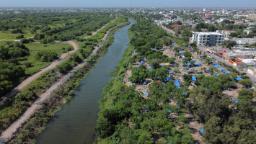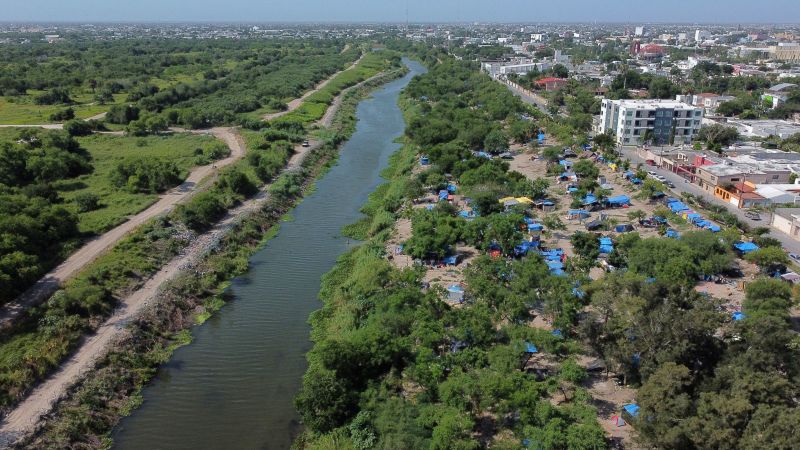
A version of this story appears in CNN’s What Matters newsletter. To get it in your inbox, sign up for free here.
CNN
—
There is a tendency to view the different elements of the immigration landscape in isolation.
- Texas is being sued by the US Department of Justice for acting on its own to put obstructions along the border.
- New York and other cities complain they are overwhelmed by buses of migrants being sent from the border.
- In the absence of action by Congress, court decisions are setting US border policy.
But the elements are all interrelated.
I talked to CNN’s Priscilla Alvarez to get her perspective as a White House reporter with a deep background in reporting on all aspects of the larger immigration story. Our conversation, conducted by email, is below. And don’t miss her story that published Tuesday: Federal judge blocks Biden’s controversial asylum policy in a major blow to administration.
WOLF: The US government is suing Texas to remove floating barriers from the Rio Grande. But it’s just the latest in a series of escalating measures Texas has undertaken on its own to keep migrants out of the country. What is the state of play at the border?
ALVAREZ: The handling of the US-Mexico border has long been a point of contention between President (Joe) Biden and Texas Gov. Greg Abbott, who’s argued that the administration hasn’t done enough to enforce the border.
As an affront to Biden’s border policies, Abbott has transported migrants to Democratic-led cities without coordinating with city officials, deployed more personnel to the Texas-Mexico border, and earlier this month, installed buoys in the Rio Grande.
Border agents have historically worked closely with the Texas National Guard and the Texas Department of Public Safety. But the latest steps taken by the state have made day-to-day operations more difficult.
DPS made certain portions of the Texas-Mexico border more difficult to access, marking a departure from the coordination that previously existed between law enforcement. Agents on the ground have also sent regular reports to US Customs and Border Protection headquarters about what they’ve observed as Abbott’s operation has been underway, a Homeland Security official told me.
But disturbing images of migrants with injuries and troubling reports of Texas troops pushing migrants back to Mexico forced the Biden’s administration hands.
Last week, the Justice Department said it’s assessing the situation along the Texas-Mexico border and on Monday, the DOJ filed a lawsuit on a separate, though related matter: the installation of a floating barrier. The lawsuit says Texas didn’t seek authorization before placing the floating barrier in the Rio Grande and poses a threat to navigation.
That court battle could take months to play out. But in the interim, it could fuel tensions between agents and troops on the ground and further escalate the feud between Biden and Abbott.
WOLF: You’ve written about how an expected surge of migrants after the end of a Covid-era policy known as Title 42 never materialized. What happened?
ALVAREZ: Let’s provide some context first. Migration often ebbs and flows.
But the Biden administration has had to grapple with unprecedented mass movement of people in the Western hemisphere, which is in part the outcome of the coronavirus pandemic decimating conditions in the region.
The administration relied on a public health authority, known as Title 42, to quickly expel migrants back to Mexico or their origin countries. That authority had been invoked under former President (Donald) Trump and used to turn away migrants, including asylum-seekers, at the US-Mexico border on public health grounds.
In the days leading up to the expiration of Title 42, thousands of migrants tried to cross the US southern border, knowing that they could face tougher penalties after the end of the authority including bans on reentry to the United States.
And that’s indeed been the case. Increased deportations and tougher policies, paired with other, new legal pathways to the United States, appear to have driven down the number of people attempting to unlawfully cross the US-Mexico border.
In June, for example, US Border Patrol arrested nearly 100,000 migrants along the US southern border, marking a decrease from May and marking the lowest monthly border encounters since February 2021, according to US Customs and Border Protection data.
WOLF: Far from the border in Texas, New York Mayor Eric Adams, after earlier welcoming migrants bused to his city, has said with increasing urgency that the city is full. Migrants are now also being bused to Los Angeles. What’s the latest on the busing angle?
ALVAREZ: The busing is still happening. Since last year, Texas has bused more than 27,000 migrants to six cities, according to Abbott’s office. The cities include Washington, DC, New York City, Chicago, Philadelphia, Denver and Los Angeles.
One of the main issues with the transport of migrants to these cities that officials often raise alarm about is the lack of coordination. The governor’s office doesn’t generally notify cities that migrants are being sent there, leaving border NGOs (nongovernmental organizations) to try to fill the information void.
It’s important to note, though, that migrants who are released from government custody have been vetted and processed by federal authorities and are released as they go through their immigration court proceedings. An immigration judge ultimately decides whether a migrant has grounds to stay in the United States or be ordered removed.
WOLF: All of these things are related – the efforts by Texas to create its own border policy, the difficulty New York and cities are facing as they deal with an influx of migrants … everything feeds from the lack of more comprehensive immigration reform. Is there any movement in Congress toward dealing with all of this in a comprehensive way?
ALVAREZ: Bills addressing the immigration system have been introduced by both parties. Republican Rep. Tony Gonzales of Texas, for example, has introduced legislation that addresses work visa programs, among other parts of the system. But it’s such a divisive issue that legislation struggles to move forward.
Both parties are so far apart on the issue that even though Democrats and Republicans acknowledge the US immigration system is broken, they can’t agree on how to fix it.
Without comprehensive reform, the federal government is left to implementing a patchwork of policies and then playing defense when lawsuits are filed against them, often resulting in policy whiplash.

